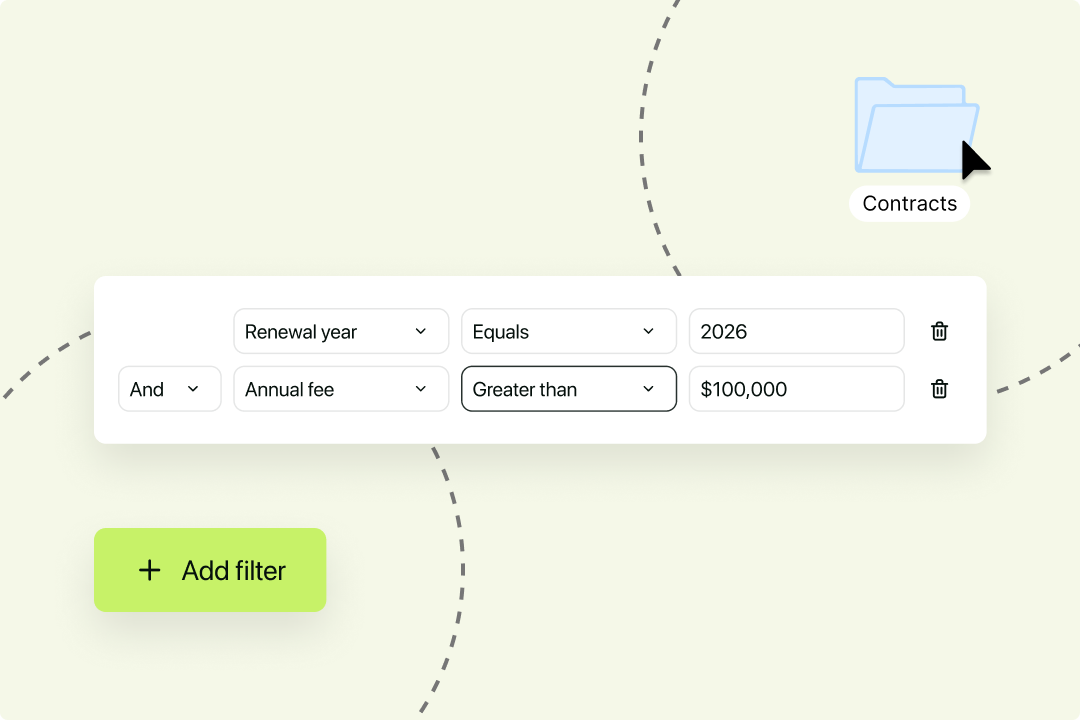Solutions
Customer Support
Resources
Contracts are used to reduce risk in commercial transactions. They provide certainty, hold parties accountable and offer legal protection to businesses entering into agreements.
But contracts can carry risk too. This post explores what contract risk is, what it looks like and how contract risk management can help. Read on to find out more.
Contract risk is used to describe instances where companies become vulnerable, either legally or financially, due to the contents or handling of a contract.
This is a broad definition. But that’s because contract risk can manifest itself in many different ways.
As we just mentioned, contracts can carry many different risks. Contract risks can be categorized into four main types: financial, legal, reputational, and security risks. Let’s explore some examples of each type now.
Financial contract risk is used to describe any way that a contract’s contents or management can leave the company susceptible to financial loss or harm, beyond your level of risk appetite.
Value leakage and missed contract renewals are both prime examples of financial contract risk.
One common example of contract risk is value leakage. This is usually a result of poor contract processes and can result in the actual value of a contract falling short of what was originally expected.
This can occur due to businesses spending too much time laboring over contract admin for low-value, standardized contracts. However, it can also be a result of an unsuccessful approach to contract negotiations, or the use of unapproved pricing models.
Too much value leakage can jeopardize your company’s financial position, and this can be detrimental in the long run.
Another instance where financial contract risk may occur is if you miss a contract renewal deadline. If this happens, it’s possible that your contract with a vendor will be automatically renewed, whether you wanted it to be or not.
This mistake is commonplace within businesses that don’t track their contracts effectively, and it can result in unnecessary and unanticipated costs for the business. Fortunately, it can often be prevented using contract reminder software.

Legal contract risks occur when a contract fails to comply with legal requirements or is broken in some way. Most often, this type of contract risk can result in legal action, or a threat of it.
Breached contracts and failure to comply with regulations are just two examples of legal contract risk.
One of the most recognized contract risks is a breach of contract. As we’ve discussed in previous posts, this happens when a party fails to perform what they had promised within the contract.
For example, if your contract promises that you will deliver goods to a customer on a certain date, but you fail to do so, you’ve breached the contract and could be subject to legal action.
The implications of this are obvious. Firstly, legal action is costly. However, it can also result in the breakdown of the commercial relationship. What’s more, if others find out about this breach, it could also result in reputational damage.
Since commercial teams often lack legal expertise, drafting contracts without legal’s oversight can be extremely risky. One reason for this is that their version of a contract may not comply with the relevant regulations.
This could render the contract invalid, or result in one of the parties breaking the law. Again, this is far from ideal.
Another type of risk in contracts is reputational risk. This type of risk occurs when a company is portrayed badly or is discussed in a negative light. Including controversial or unreasonable terms within a contract is one way that reputational risk can occur.
Another instance where contract risk might occur is if a contracting party includes controversial or unfair terms within the contract.
We’ve likely all seen instances where a candidate has shared distasteful or inconsiderate employment contract terms online. And unsurprisingly, this usually results in damage to that employer’s reputation.
Another famous example of how unfair contracting can result in reputational damage is the use of the 'fire and rehire' approach. Under this approach, an employer dismisses an employee and rehires them on less-favourable terms, like lower pay or fewer benefits. A few companies are guilty of this, and they've been heavily criticized as a result.
It's important to remember that reputational damage caused by contracts can have a knock-on effect on other business objectives like revenue and hiring, too.
One of the biggest contract management mistakes that businesses can make is failing to secure contracts and the data within them. This is a significant source of risk within contracts, and one that should be mitigated at all costs.
Weak security when storing contracts is in and of itself a contract risk. If highly confidential contracts, or any contracts for that matter, end up with the wrong people due to poor storage practices, you could have a big problem on your hands.
Firstly, you will have failed to protect their data and respect their privacy, which is often against the law. Secondly, you’ve damaged their trust. This is something that you’re unlikely to get back and will often result in the loss of a client. If the breach is severe, you may even lose multiple clients.
Another contract risk to consider is the loss or displacement of contracts as a result of poor contract storage measures. It’s common for legal and business teams to save signed contracts as PDFs and scatter them across shared drives.
It works, yes. But is it the safest and most organized way to store contracts? Absolutely not.
There’s no guarantee that these contracts will be saved in the first place, and even if they are, finding them within unorganized legal drives can be near impossible for businesses that manage large volumes of contracts.
Contract risk management is the process of evaluating the risk contained within a contract and taking conscious steps to mitigate it.
While it’s not possible to eliminate all risks associated with contracts, it is possible to minimize this risk by following thorough review processes and establishing safeguards throughout the contract process.
Let’s explore some of the best ways to approach contract risk management together now.
It’s important to be realistic about your capacity when entering into a contract. At best, overpromising typically results in disappointment. At worst, it can result in a contract being breached.
While it may be tempting to make ambitious promises to counterparties to get contracts over the line, you also need to ensure that these promises can be met. If they aren’t, you open the business up to legal risk.
The best way to ensure that your promises align with your resources is by getting the relevant stakeholders involved early on in the process. This cross-collaboration helps to ensure that the promises you make are consistent with capacity right across the business.

Another effective way to manage contract risk is to use limitation of liability clauses. How and when they should be used can vary between different types of contracts.
However, these clauses can be used to impose a limit on the value of damages that a counterparty can ask for in the event of negligence or breach. Alternatively, they can be used to exclude liability in certain circumstances.
Either way, limitation of liability clauses can reduce contract risk by capping it.
Another tip for effective contract risk management is to establish and follow thorough contract review processes. A robust review process helps to identify contract risk before the agreement is pushed out to counterparties for negotiation.
Specifically, it provides legal and business teams with the opportunity to:
Another opportunity to reduce contract risk is by setting up reminders for upcoming contract renewal deadlines. This helps to ensure that contracts are only renewed when you want them to be, which is important for financial efficiency.
This is best achieved through contract reminder software, or a contract automation tool like Juro that offers automated contract reminders for upcoming deadlines.

Another way to reduce contract risk is to ensure your contracts are watertight.
One way to do this is by setting up an approval workflow whereby senior stakeholders are asked to approve the contents of a contract before it can be sent out for signing. How and when these approvals are requested can be codified within a contract playbook, or automated using a tool like Juro.
Automating your contract approval workflows is often more efficient, though. This is because a tool like Juro enables you to establish approval orders at a template level or when certain conditions are met within the contract, like if the contract is over a certain value threshold.

Regardless of which rules you set, contract approval workflows are a useful way to ensure that contracts don't progress without the oversight of key stakeholders. Plus it helps to ensure that high-value contracts are reviewed thoroughly before being shared with the counterparty. This, in turn, reduces contract risk.
Improving visibility into your contract portfolio is also an effective way to mitigate contract risk. In fact, by making it easier to search for and find contracts, you can reduce all types of contract risk.
Better visibility enables you to:

Businesses are also obliged to store contracts and their data more securely to reduce contract risk. This can involve a few things.
For example, businesses could reduce contract risk by storing contracts safely within a robust contract repository. They could even encrypt contract data, or set strict permission controls on certain contracts.
Businesses should also ensure that their electronic signatures meet legal requirements, like the eIDAS Regulation.
One of the most efficient ways to minimize contract risk at scale is to standardize contracts where possible. This helps to ensure consistency across legal documents and prevent costly mistakes when commercial teams self-serve on contracts.
This approach is particularly effective for simple contracts like NDAs, MSAs, employment offer letters and DPAs, and it can be achieved using contract templates and features like conditional logic.

To recap: we’ve discussed what contract risk is, when it occurs and what can be done to mitigate it. What we haven’t explored, however, is the role that contract risk management software plays.
As you’ve probably guessed by now, contract risk management software is a piece of technology used to make mitigating contract risk simple. It does this by improving the processes used to manage contracts in the first place.
Juro’s contract automation software is a great example of this. Juro’s all-in-one tool enables users to:
{{quote1}}
Want to find out more? Book a personalized below to hear more about how Juro can help to reduce contract risk for your business.
Lorem ipsum dolor sit amet, consectetur adipiscing elit. Suspendisse varius enim in eros elementum tristique. Duis cursus, mi quis viverra ornare, eros dolor interdum nulla, ut commodo diam libero vitae erat. Aenean faucibus nibh et justo cursus id rutrum lorem imperdiet. Nunc ut sem vitae risus tristique posuere.

